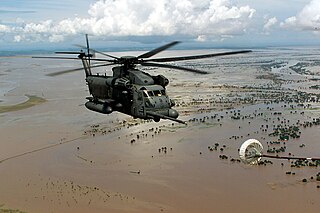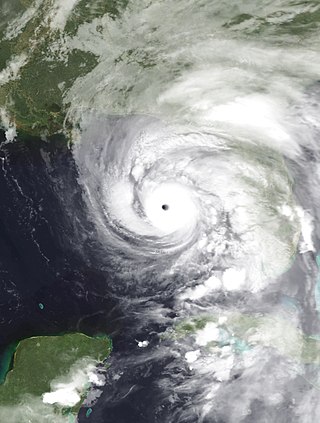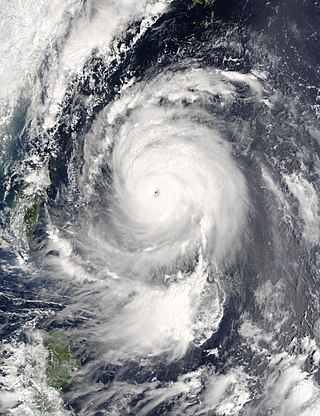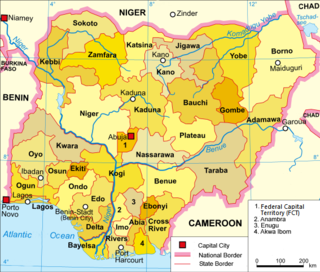Related Research Articles

The 2000 Mozambique flood was a natural disaster that occurred in February and March 2000. The catastrophic flooding was caused by heavy rainfall caused by Cyclone Leon-Eline that lasted for four weeks and made many homeless. Approximately 800 people died, 1400 km2 of arable land was affected and 20,000 head of cattle and food were lost. It was the worst flood in Mozambique in 50 years.

Hurricane Dennis was briefly the strongest Atlantic hurricane ever to form before August. A deadly and destructive tropical cyclone, Dennis was the fourth named storm of the record-breaking 2005 Atlantic hurricane season. It originated on July 4 near the Windward Islands from a tropical wave. Dennis intensified into a hurricane on July 6 as it moved across the Caribbean Sea. Two days later, it became a strong Category 4 on the Saffir-Simpson scale before striking Cuba twice on July 8. After weakening over land, Dennis re-intensified in the Gulf of Mexico, attaining its lowest barometric pressure of 930 mbar (27 inHg) on July 10. That day, Dennis weakened slightly before making a final landfall on Santa Rosa Island, Florida as a Category 3 hurricane. Six days later, Dennis's record intensity was surpassed by Hurricane Emily. After moving through the central United States, the circulation associated with former Hurricane Dennis dissipated on July 18 over Ontario.

Typhoon Maemi, known in the Philippines as Typhoon Pogi, was the most powerful typhoon to strike South Korea since record-keeping began in the country in 1904. Maemi formed on September 4, 2003, from a disturbance in a monsoon trough in the western Pacific Ocean. It slowly intensified into Tropical Storm Maemi while moving northwestward, becoming a typhoon on September 8. That day, favorable conditions facilitated more rapid strengthening; the storm developed a well-defined eye and reached peak maximum sustained winds of 195 km/h (121 mph). While near peak intensity, Maemi decelerated and began turning to the north-northeast. Soon after, the eyewall passed over the Japanese island of Miyako-jima on September 10 and produced an air pressure reading of 912 mbar (26.9 inHg), the fourth-lowest recorded in the nation. Due to warm waters, Maemi was able to maintain much of its intensity before it made landfall just west of Busan, South Korea, on September 12. The typhoon became extratropical in the Sea of Japan the next day, although its remnants persisted for several days, lashing northern Japan with strong winds.

Tropical Storm Fay was the sixth named storm of the 2002 Atlantic hurricane season; it was a moderate tropical storm which caused flooding in parts of Texas and Northern Mexico. It formed from a trough of low pressure that moved south into the Gulf of Mexico, and became stationary. A low pressure center developed along this trough, and on September 5, a Hurricane Hunter aircraft reported that the system had gained sufficient organization to be classified a tropical depression, 95 miles (153 km) southeast of Galveston. The depression drifted south-southwest while strengthening, reaching its peak strength of 60 miles per hour (97 km/h) on the morning of September 6. The system then made an abrupt turn to the west-northwest, and remained steady in strength and course until landfall the next day, near Matagorda. The system weakened rapidly after landfall degenerating into a remnant low on September 8, but the storm's circulation survived for another three days.

Typhoon Xangsane, known in the Philippines as Typhoon Milenyo, was a typhoon that affected the Philippines, Vietnam, and Thailand during the 2006 Pacific typhoon season. The name Xangsane was submitted by Laos and means elephant.

In October 1999, severe flooding affected portions of eastern Mexico and Central America. Rainfall in September preceded the primary event in Mexico, which moistened soils. On October 4, Tropical Depression Eleven developed in the Gulf of Mexico, which drew humidity from the gulf and the Pacific Ocean to produce torrential rainfall in mountainous regions of eastern Mexico, reaching 43.23 in (1,098 mm) in Jalacingo, Veracruz. This was the third-highest tropical cyclone-related rainfall total in Mexico from 1980–2006, and the event caused the highest rainfall related to tropical cyclones in Veracruz, Hidalgo, and Puebla. In some locations, the daily rainfall represented over 10% of the annual precipitation total. The heaviest rainfall occurred in mountainous regions that were the mouths of several rivers. A broad trough absorbed the depression on October 6, and rainfall continued for the next few days. Additional rainfall occurred in Tabasco state on October 18. The floods were estimated as a 1 in 67 year event in one location, although such floods are expected to affect eastern Mexico twice per century, the last time being 1944.

The October 2008 Central America floods were caused by a series of low-pressure areas including Tropical Depression Sixteen, a short-lived tropical cyclone in the 2008 Atlantic hurricane season that made landfall in Honduras. Heavy rainfall began in early October 2008 while a tropical wave passed through the region. On October 14, Tropical Depression Sixteen formed just off the northeast coast of Honduras, and at the same time a low-pressure system was on the Pacific coast. Both systems increased rainfall across the region, although the depression dropped heavy rainfall close to its center when it moved ashore on October 15. Although Tropical Depression Sixteen quickly dissipated over land, its remnants persisted for several days. Another low-pressure area interacted with a cold front on October 21, adding to the rainfall in the region.

Severe Tropical Storm Meari, known in the Philippines as Severe Tropical Storm Falcon, was an unusually large tropical cyclone that caused significant damage from the Philippines to the Korean Peninsula in June 2011.

Tropical Storm Nicole was a short-lived and unusually asymmetrical tropical cyclone that caused destructive rainfall and flooding in Jamaica during the 2010 Atlantic hurricane season. It was the sixteenth tropical cyclone and the fourteenth named storm of the season, as well as the last of eight tropical storms to form in September. Originating from a broad monsoonal low, Nicole became a tropical depression over the northwestern Caribbean Sea on September 28. It maintained an unusual structure as it tracked northeastward, with a poorly defined wind circulation and few thunderstorms near its center. Nicole approached the coast of Cuba as a weak tropical storm, losing its status as a tropical cyclone over the territory on September 29. The remnants emerged over the Bahamas and eventually became absorbed by a separate extratropical system.
The 2010 Nigerien floods were floods across Niger which left over 111,000 people homeless. Niger was already suffering acute food shortages following prolonged drought in the Sahel region. As of 24 August 2010, at least 6 to 8 people had died. The Niger river was pushed to its highest levels in 80 years. The floods subsequently spread along the River Niger into Nigeria, Ghana, Burkina Faso, Togo and Benin over the next few months. Later storms also brewed up in the CAR, Morocco and northern Algeria.

The National Disaster Management Organisation (NADMO) is the government agency that is responsible for the management of disasters as well as other emergencies in Ghana. The board operates under Ghana's Ministry of Interior.

Severe Tropical Storm Linfa, known in the Philippines as Tropical Storm Chedeng, brought deadly flooding to areas of the Philippines and Japan in May and June 2003. The fourth named storm within the northwestern Pacific that year, Linfa developed as a tropical depression just off the western coast of Luzon on May 25. The disturbance quickly intensified to reach tropical storm intensity a few hours after cyclogenesis. However, intensification leveled off as Linfa executed a small clockwise loop before a subsequent landfall on Luzon on May 27. Due to land interaction the storm temporarily weakened and decoupled before reforming in the Philippine Sea. Afterwards Linfa began reintensifying and reached its peak intensity on May 29 with maximum sustained winds of 100 km/h (65 mph) and a barometric pressure of 980 mbar. Following its peak the tropical storm began to deteriorate and transitioned into an extratropical cyclone on May 30; these extratropical remnants continued to track northward through Japan before dissipating in the Sea of Okhotsk on June 4.

The 2012 Nigeria floods began in early July 2012. It killed 363 people and displaced over 2.1 million people as of 5 November 2012. According to the National Emergency Management Agency (NEMA), 30 of Nigeria's 36 states were affected by the floods and the two most affected areas were Kogi and Benue States. The floods were termed as the worst in 40 years, and affected an estimated total of seven million people. The estimated damages and losses caused by the floods was N2.6 trillion.

Melcom is a supermarket chain consisting of 65 shops spread all over Ghana. It was started in 1989 by Indian magnate Bhagwan Khubchandani. His late father, Ramchand Khubchandani, had arrived in the then Gold Coast in 1929 as a 14-year-old to work as a store boy. Melcom Group of Companies is a family business.
Weija Dam is a dam on the Densu River which supports the main water treatment plant for Accra in the Greater Accra Region of Ghana. It is operated by the Ghana Water Company.This supplies about 80 percent of the potable water for the entire city of Accra and its surrounding environs. Its construction began in 1974 and was completed in 1978 by Messrs Tahi, an Italian Company.
Floods in Ghana refer to a series of flood incidents that have caused property damage and loss of life. Floods are caused by excessive rainfall and dam spillages.

In early September 2024, Vijayawada, a city in Andhra Pradesh, India, experienced severe flooding triggered by exceptionally heavy rainfall that began on August 31, 2024. The floods resulted in at least 35 deaths in NTR district and significantly impacted approximately 270,000 people in Vijayawada alone. The disaster was characterized by over 29 cm of rainfall in a single day, which overwhelmed the Krishna River and Budameru Rivulet. The flooding caused extensive damage to infrastructure, homes, and agricultural land. The extreme rainfall caused catastrophic flooding, severely damaging infrastructure, homes, and agricultural land. The flooding exposed critical issues with the city's flood management infrastructure and urban planning, highlighting the urgent need for improved measures to handle such extreme weather events.
The 2011 Atiwa District floods occurred in the early hours of Monday, July 20, 2011, in the Eastern Region of Ghana. A heavy downpour of about 10 hours of torrential rain caused the Birim River to overflow its banks, resulting in widespread flooding of houses and farmlands in various communities. The towns most affected included Anyinam, Asaman Tamfoe, Osonase, Abomosu, Jejeti, Akwabooso, and Asunafo, all located within the Atiwa District. The flooding led to severe damage to infrastructure, homes, and agricultural lands, displacing many residents and cutting off some towns from the rest of the country due to impassable access roads.
Ghana is prone to a range of natural disasters, including floods, droughts, landslides, fires, and, on rare occasions, earthquakes. Among these, floods are the most common, often leading to outbreaks of waterborne diseases such as cholera, typhoid, and malaria. Historically, disaster management in Ghana has been largely reactive, focusing on response and relief efforts. However, in recent years, there has been a shift towards prevention and mitigation, with efforts to integrate disaster risk reduction and climate change adaptation into development planning.
Here is a list of all floods which occurred in Ghana in 2023 across all regions.
References
- ↑ "Ghana - Floods Situation Report #3, 5 July 2010 - Ghana | ReliefWeb". reliefweb.int. 2010-07-05. Retrieved 2024-09-11.
- ↑ "Accra Floods: 27 years of democracy, 7 General Elections den 5 Presidents but still Ghana dey flood every year". BBC News Pidgin. 2019-05-30. Retrieved 2024-09-11.